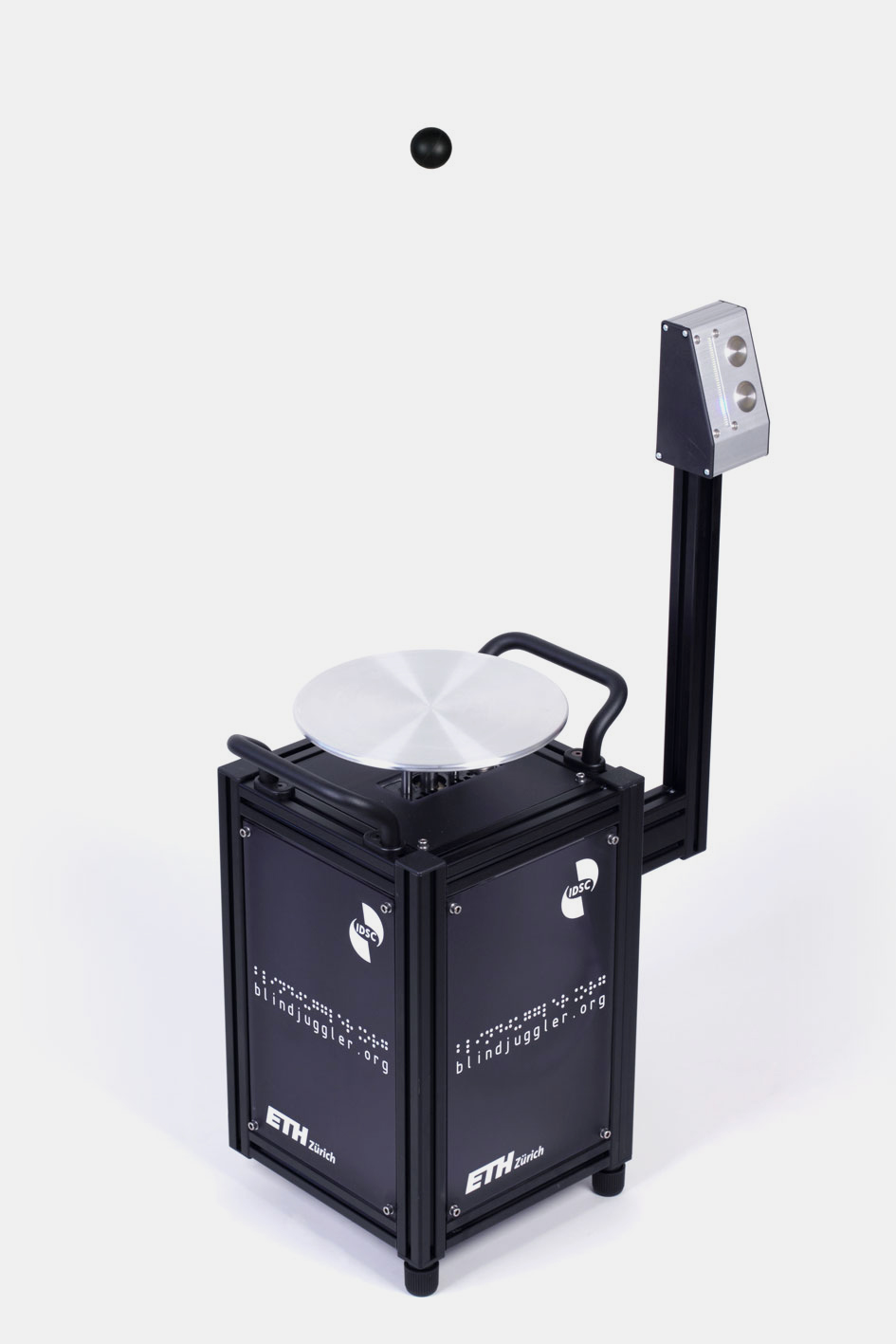
Controlling the Uncontrollable
At first, this task seems impossible. If the identical balls start at the same height and with the same velocity, they would move together on identical paths, no matter how the paddle is moved. Indeed, dynamical system theory classifies this system as uncontrollable (in a deterministic sense). Read more about controllability here.
However, the task is not impossible, as is demonstrated in the following video:
MISSING VIDEO
With a higher frequency paddle motion, we can amplify these small disturbances, causing the balls to move along individual paths. The mathematical term for this is chaos. When the balls are predicted to transition to the desired combination of stable ball motions (see basins of attraction here), we switch the paddle motion from one that induces chaos to one that stabilizes the desired juggling pattern. The system is not really uncontrollable: since we rely on random disturbances to control the system, we say that the system is controllable in a stochastic sense.
Our research addresses some of the challenges involved in this control strategy:
- In order to figure out when the balls are in the right configuration for switching the paddle motion, we need to predict to what periodic orbits the balls transition to when we switch. We currently use “maps” of the basins of attraction of the periodic orbits that we generate in simulation. Clearly visible in Figure 2 on the periodic orbits section is the complex shape of these basins, which suggests that they are not straightforward to estimate. Second, the basins found in simulation where the balls and the paddle motion are perfect will differ from the true basins that are observed with the experimental setup. A key component of the research will be to combine experimental data into the strategy, for example by adjusting the estimate of the basins of attraction given the measured data.
- Because we rely on a random process to bring the balls to the basins of attraction of the desired juggling pattern, we might wait for a very long time, especially if many balls are to be controlled into a specific juggling pattern (imagine many many coins being tossed in the controllability example). One of the key problems we address is how to make this transition efficient in terms of wait time. One possible strategy is to apply feedback: Continuously measure the ball heights and velocities, and figure out how to move the paddle to get the balls into the right configuration more quickly.
Below is a video of Philipp Reist giving a talk about this research:
MISSING VIDEO
Publications
papers
2013: Control of a Swinging Juggling Robot: 12th Biannual European Control Conference (ECC). PDF. BIB. Download additional multimedia material here.
2012: Control of Nonlinear Systems with Symmetries using Chaos: IEEE International Conference on Decision and Control (CDC). PDF. BIB. DOI.
2012: Design and analysis of a Blind Juggling Robot: IEEE Transactions on Robotics. PDF. BIB. DOI. Download additional multimedia material here (contains Matlab and Mathematica scripts as well as videos).
2011: The Pendulum Juggler. IEEE International Conference on Robotics and Automation (ICRA). PDF. BIB. DOI. Download Mathematica Notebook describing the perturbation analysis here.
2010: Simulation-Based LQR-Trees with Input and State Constraints. PDF. BIB. DOI.
2009: Bouncing an Unconstrained Ball in Three Dimensions with a Blind Juggling Robot. IEEE International Conference on Robotics and Automation (ICRA). PDF. BIB. DOI. Download Mathematica Notebooks describing the nominal ball trajectory here and perturbation analysis here.
ETH Student Theses
Fabian Byland, Bachelor Thesis, 2013: Impact Detection Hardware for the Cloverleaf Blind Juggler.
Matthias Fässler, Semester Project, 2010: Estimation of Ball Coefficient of Restitution for the Blind Juggler.
Flavio Fontana, Master Thesis, 2012: Control of a Swinging Juggling Robot.
Andrea Katharina Fuchs, Semester Project, 2009: A Dynamics Simulation for the Multiple-Balls Blind Juggler.
Arsin Grünig, Semester Project, 2011: Vision Feedback for the Blind Juggler.
Lukas Koch, Master Thesis (in progress), 2015: Design of a Science Museum Exhibit.
Baptiste Mottet, Semester Project (in progress), 2015: Probabilistic Basins of Attraction for a Juggling Machine.
Alessandro Schär, Bachelor Thesis, 2013: The Circular Cloverleaf Blind Juggler.
Tobias Sutter, Bachelor Thesis, 2010: A Dynamical Approach to Create Different Juggling Patterns Using Chaos. Report
Ueli Wechsler, Bachelor Thesis (in progress), 2015: Mechatronic System Design for the Swinging Blind Juggler.
Educational Handout
Hallie Siegel has created a handout explaining the basic principle of the juggler which you can download here.
